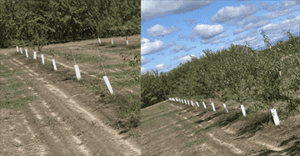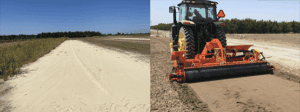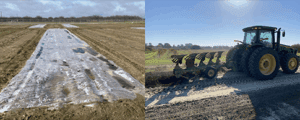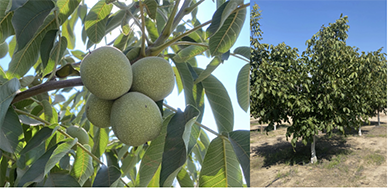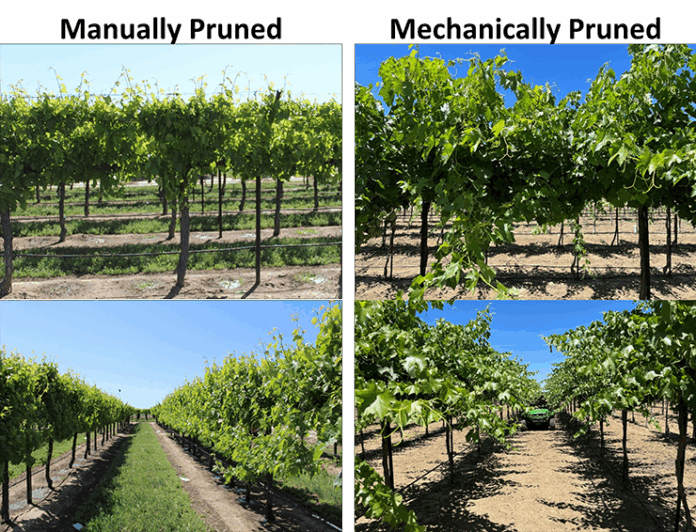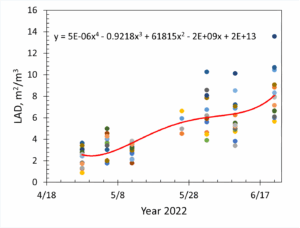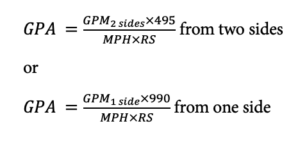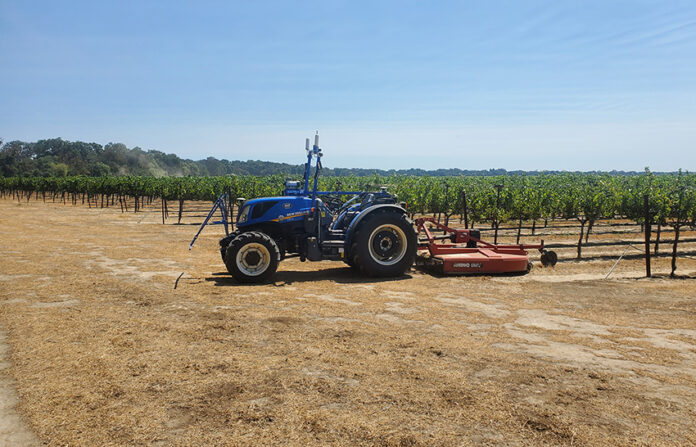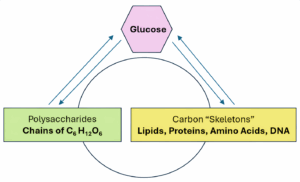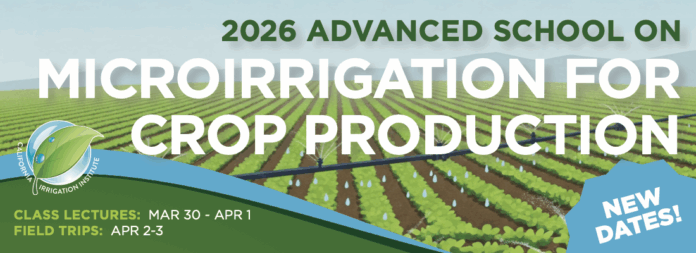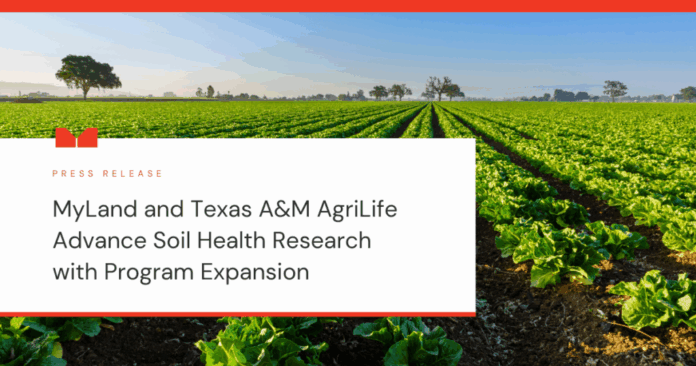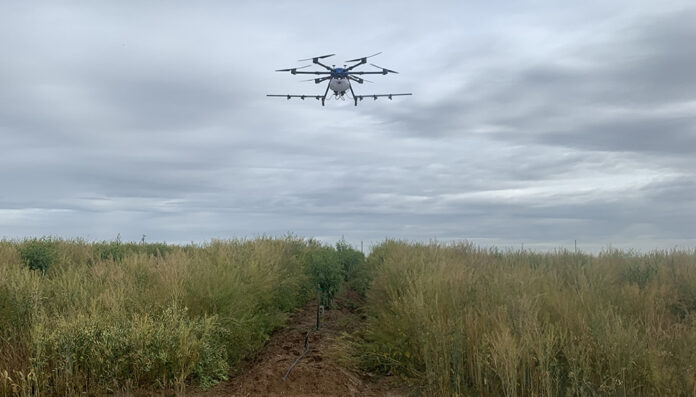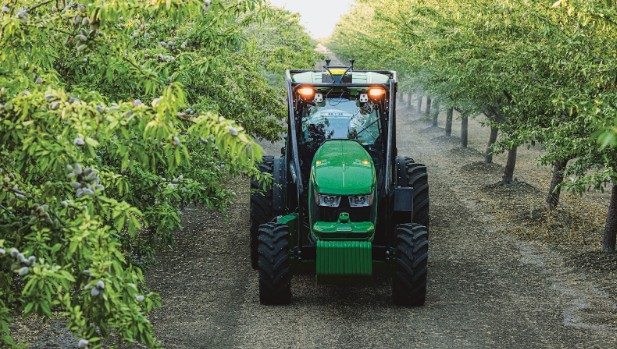The USDA’s Economic Research Service recently released its 2024 agricultural production summaries, highlighting that California agriculture reached a total value of $61.2 billion, maintaining its position as the nation’s leader. This is encouraging news for the state and for California’s growers, who produce several specialty crops unique to the Golden State. In fact, nearly half of all U.S. vegetables and more than three-quarters of the nation’s fruits and tree nuts are grown in California. The state’s top 10 commodities exceeded $1 billion in farm gate value in 2024, ranging from $8.6 billion for dairy products to $1.4 billion for broilers (Table 1). Pistachios achieved a record valuation of $2.05 billion in 2024, with expectations of surpassing that figure this season.
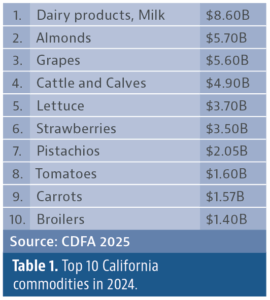
However, what do these strong figures truly mean for growers and farm managers? Despite the impressive statewide performance, many growers continue to face significant financial pressures affecting their bottom line. Rising production costs, driven largely by California’s complex regulatory environment, pose ongoing challenges for growers. A recent study from California Polytechnic State University, San Luis Obispo found that compliance costs for environmental, labor and food safety regulations have increased by more than 63% over the past seven years. For example, regulations alone account for 12% of the total production cost of lettuce, or approximately $1,600 per acre. Similar regulatory costs can be attributed to other specialty crops, too. When these regulatory costs are added to California’s already high production expenses, it becomes increasingly difficult for growers to remain profitable.
As California Farm Bureau President Shannon Douglass aptly stated, “Producers cannot continue to bear the burden of ever-increasing costs while their ability to remain competitive erodes. If policymakers fail to strike a better balance, California risks losing its ability to produce high-quality food, sustain jobs and preserve green rural spaces that benefit everyone.”
Precision Agriculture
With the continually rising cost of doing business in California, many growers are asking themselves, “How can I remain profitable?” The reality is mixed. Some producers are struggling, selling land, operating at a loss or merely breaking even, while others are maintaining profitability through a strong focus on efficiency and innovation. One promising strategy gaining momentum among California growers is precision agriculture.
Although there is no single, universally accepted definition, most universities and federal agencies agree that precision agriculture involves identifying variability within fields and using advanced technologies, such as GIS, GPS, crop performance data and site-specific information, to manage inputs and practices spatially. One grower described it simply as “the collection and use of data sets that must be interpreted by someone with a technological background.”
Perhaps the most comprehensive definition comes from the UC Davis Digital Agriculture Laboratory, which states: “Precision Agriculture is defined as the site-specific and timely management of crops, based on data-driven procedures to enhance agricultural efficiency by minimizing inputs and waste and maximizing yield quantity and quality while protecting the environment and ensuring sustainability.”
Regardless of the definition, success in precision agriculture depends on a grower’s commitment to regular data collection, interpretation and application. Those who consistently analyze and act on data are more likely to achieve measurable returns on investment, such as improved yield, higher quality and reduced input costs.
The concept of precision agriculture dates to the 1980s, when it was first researched and adopted in the corn, soybean, cotton and wheat fields of the Midwest. Early efforts focused on grid soil sampling, which allowed for laboratory analysis and the creation of field maps that revealed low-performing areas. The maps helped growers identify where to adjust pH levels or apply nutrients and soil amendments to balance productivity across fields.
By the late 1980s and early 1990s, researchers were testing yield monitoring systems combined with GPS data, enabling growers to layer yield data over soil sampling grids. This innovation led to the development of variable-rate technology, allowing growers to apply fertilizers, seeds or other inputs at different rates across a field based on real-time soil and yield data. Over time, this capability has helped growers track performance annually and make targeted adjustments to boost productivity. Given the millions of contiguous acres of row crops in the Midwest, it’s no surprise that precision agriculture originated there and has continued to improve, benefiting agriculture nationwide.
In contrast, adoption in western states, where high-value specialty crops like pistachios, grapes, citrus and strawberries dominate, has been slower due to the permanent nature of the crops. University research on precision agriculture for these crops did not begin until the 1990s, initially focusing on major row crops. However, growing interest in reducing input costs for activities like spraying, fertilizing and irrigating has accelerated both research and adoption in California and other Western states. Today, precision agriculture is increasingly seen as a collection of critical tools for improving sustainability and competitiveness in the specialty crop sector. In addition to traditional practices, such as collecting soil samples to assess pH levels, soil amendment requirements and site-specific yield data, western growers now have access to many more precision agriculture technologies that significantly enhance crop yield, product quality and overall profitability.
What Tools Are California’s Specialty Crop Growers Using?
Precision agriculture has advanced dramatically since its early days of university research in the 1990s. Proximity to Silicon Valley meant it was only a matter of time before technology and agriculture would intersect in meaningful ways. In the early years, however, many ag tech startups focused on solving problems that growers didn’t actually have, which often led to strained relationships between innovators and growers. Over time, these companies realized that their greatest shortcoming was the absence of agricultural expertise on their teams. Once they began incorporating professionals with farming and crop management experience, their solutions became far more practical and impactful. Today, many of those early startups have evolved into key partners in modern agriculture, helping growers apply technology to solve real-world challenges.
One of the most successful applications of precision agriculture in specialty crops has been in water delivery and management. The first perennial crop in California to adopt a managed or low-volume irrigation system was a 5-acre avocado orchard in San Diego County. Adoption was initially slow, with approximately 5% of all irrigated acreage using drip irrigation in 1988. It took a major drought to motivate wider investment in these systems. Since then, drip and microirrigation technologies have become standard practice among perennial crop growers across the state.
The next major step in irrigation innovation is the automation of irrigation systems, which understandably makes some growers and farm managers apprehensive, much like the hesitation seen during the first steps toward drip irrigation in the 1970s. However, today’s knowledge base and technical capacity are far more advanced. Skilled irrigation specialists can now retrofit nearly any system for automation. While the initial investment can be substantial, growers typically see a return through reduced water usage, lower pumping costs and decreased labor expenses. Still, success requires dedicated oversight by either continued staff training or a designated employee to monitor system performance and ensure data-driven operation for maximum return on investment.
Another rapidly advancing tool in precision agriculture is the on-farm weather station. These stations began appearing in vineyards and orchards during the 1990s, initially to collect climate data used in pest management modeling. Since then, they have evolved into fully integrated components of modern farm management systems. Today’s weather stations collect a range of data, including temperature, humidity, soil moisture, nutrient levels and irrigation flow, which can be analyzed to optimize growing conditions. With these systems in place, growers can remotely control irrigation schedules, manage acid and fertilizer applications and track pest and disease pressures with remarkable precision.
One of the most transformative advancements in agriculture over the past decade has been the development and adoption of autonomous tractors. As traditional tractors and specialized equipment have become increasingly sophisticated and costly, it has become more difficult for growers to find qualified operators capable of managing these machines efficiently. Furthermore, many farm tasks are repetitive and physically demanding, creating additional labor challenges. Recognizing these issues, technology companies have focused on automating routine fieldwork through autonomous machinery that uses GPS/GIS guidance and geofencing with great accuracy.
Autonomous tractors are now demonstrating their value across a wide range of farming operations. These machines can perform the work of several people across many acres with remarkable precision and consistency, operating for long hours without fatigue. The benefits of integrating autonomous tractors into farm operations are considerable and include:
• Reduced labor costs and improved worker safety: Automation minimizes the need for manual operation and exposure to field hazards.
• Enhanced precision and operational efficiency: GPS-guided systems ensure consistent performance, minimizing overlap and waste.
• Improved crop quality and yield: Consistent timing and precision application of inputs lead to healthier, more uniform crops.
• Greater resource and environmental sustainability: Optimized equipment usage reduces fuel consumption, emissions and soil compaction, and improves efficient use and application of chemicals.
Many growers who have adopted autonomous tractors and related technologies report achieving a rapid return on investment, often recouping costs through labor savings, increased productivity and improved operational efficiency. Moreover, as the technology becomes more widespread, the cost of autonomous equipment continues to decline, making it increasingly accessible to a broader range of agricultural operations. Additionally, farm personnel are better paid because they need to have an applied understanding of the technology being used on today’s farms.
Advancements in precision agriculture are rapidly evolving, particularly through the integration of drone technology to generate hyperspectral maps that identify challenges related to irrigation, pest infestations and overall crop health. Concurrently, cutting-edge research in robotics is poised to revolutionize the planting, management and harvesting of perennial crops, offering significant time and cost savings for growers. When combined with ongoing innovations in sensor technology and artificial intelligence, these tools empower producers to collect, organize and analyze data in real time. This capability enhances farm productivity, optimizes resource utilization and promotes a more sustainable and environmentally responsible approach to food production.
These technologies form an integrated system that enables growers to measure, analyze and respond with unprecedented accuracy. Table 2 provides an overview of the primary categories of precision agriculture that can be used, illustrating how each supports data-driven decision-making and operational efficiency. Collectively, precision agriculture innovations have moved beyond theory, resulting in a tangible, transformative approach reshaping the management of California’s specialty crops. By improving yield, enhancing quality and promoting sustainable practices, it is redefining the future of farming.
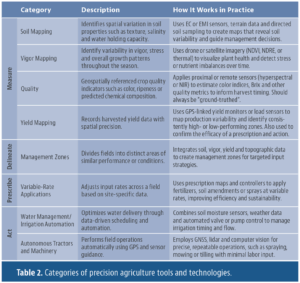
Help for Growers
Growers interested in learning more about precision agriculture and how to leverage its many benefits are encouraged to connect with qualified experts and reputable organizations that specialize in agricultural technology. A good starting point is to contact a certified crop adviser precision agriculture specialist, university extension personnel, USDA researchers or technology vendors who can provide tailored guidance, demonstrations and ongoing support for specific systems or tools of interest.
Many growers also benefit from attending field demonstrations and educational meetings where precision agriculture technologies are showcased in real-world settings. These events provide valuable opportunities to observe technology in action, ask questions and hear directly from both researchers and fellow producers.
A key resource for California growers is the UC Davis Digital Agriculture Laboratory (digitalag.ucdavis.edu), whose mission is to “optimize food production by implementing mechanized approaches that enhance yields while simultaneously reducing waste, inputs and environmental impact.” The lab serves as a hub for research, collaboration and education on data-driven, sustainable farming practices.
Another excellent organization is the Western Growers Center for Innovation and Technology (wginnovation.com), which is dedicated to advancing innovation and technological adoption in the specialty crop sector. The center connects growers with cutting-edge ideas, ag tech startups and research partners to help bring practical solutions from concept to the field.
By engaging with these and similar resources, growers can stay informed about the latest technologies, research findings, field events and educational opportunities, enabling them to identify the tools and practices that best align with their individual operations and long-term goals.
Resources
The Role of Precision Agriculture in Optimizing Orchard Water Management in California: https://progressivecrop.com/2025/01/19/the-role-of-precision-agriculture-in-optimizing-orchard-water-management-in-california/
Can Artificial Intelligence Enhance the Profit and Environmental Sustainability of Agriculture?: https://progressivecrop.com/2021/07/08/can-artificial-intelligence-enhance-the-profit-and-environmental-sustainability-of-agriculture/
John Deere Acquires GUSS Automation to Strengthen High-Value Crop Autonomy Portfolio: https://progressivecrop.com/2025/09/16/john-deere-acquires-guss-automation-to-strengthen-high-value-crop-autonomy-portfolio/
Useful Soil Maps in Microirrigated Orchards: https://progressivecrop.com/2024/02/09/useful-soil-maps-in-microirrigated-orchards/
New Tools for Monitoring Vineyard Nitrogen: https://progressivecrop.com/2024/07/15/new-tools-for-monitoring-vineyard-nitrogen/
Weather Station Use in Vineyards: https://progressivecrop.com/2021/01/04/weather-station-use-in-vineyards/
